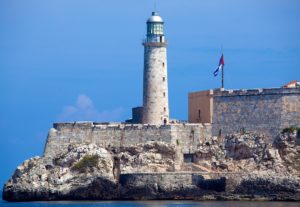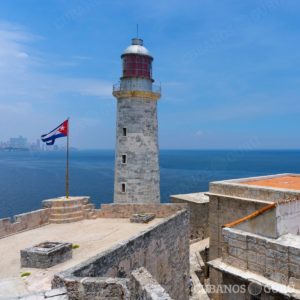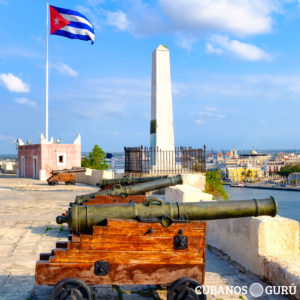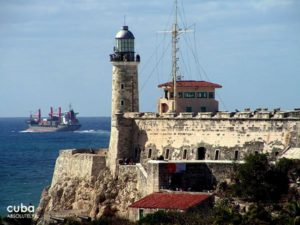 EL CASTILLO DEL MORRO, PRESENCIA AMURALLADA DE UNA CUBA QUE NO DESAPARECERA.
EL CASTILLO DEL MORRO, PRESENCIA AMURALLADA DE UNA CUBA QUE NO DESAPARECERA.
Castillo de los Tres reyes del Morro es el nombre completo de uno de los símbolos más reconocidos de La Habana, el que todos conocen simplemente como El Morro.
El Castillo de los Tres Reyes del Morro de La Habana debe su nombre por un lado a los tres reyes magos y por otra parte a la porción de terreno donde se encuentra ubicado, que se caracteriza por ser rocoso, escarpado, aislado y a la orilla del mar.
Contemplarlo desde el muro del malecón es uno de los mayores placeres que se puede disfrutar en la vida y es la foto que no falta en todo viaje a la capital habanera.
Baluarte de cubanía, la capital cubana se yergue hermosa, cautivadora y enigmática, atrapando la maravilla de lo cotidiano en los elementos más tradicionales y pintorescos de sus plazas y fortalezas, mismas que parecen desandar los tiempos a la luz de cada amanecer.
Como esos castillos que rodean la entrada de la bahía habanera, cuyas piedras centenarias se elevan como fieles guardianas sobre aguas que exhalan olores de mar y puerto en ajetreo, horadadas por siglos de oleaje y salitre.
Erigidos para defender a la ciudad en los primeros tiempos de la codicia, hoy son parte del paisaje acogedor del viajero que ha hecho su camino por el mar.
De hecho, sus murallas y fortines han devenido símbolos que distinguen a La Habana, como lo son su rutilante y viejo Malecón y tambien un recuerdo del pasado mejor de la Giraldilla.
PARA NO OLVIDAR.
El Morro, La Cabaña, La Punta, La Chorrera, dejaron atrás su misión de centinelas para regalarnos su presencia amurallada y estampa secular, convirtiéndose en museos y centros para la cultura y la recreación.
Uno de ellos y quizás el más emblemático, el Castillo de los Tres Reyes del Morro, fue erigido en la roca viva de la bahía y se alza como uno de los símbolos de La Habana.
Fue Felipe Segundo, el absolutista rey de España, quien comisionó al ingeniero militar Juan Bautista Antonelli para que lo construyera en 1589, pero no fue hasta 1630 que se terminó.
La protección de un sistema comercial establecido entre España y América, y la conservación de los territorios coloniales obligaron a crear un sistema defensivo que los salvaguardara.
DESANDANDO EL TIEMPO.
Gruesos muros, rampas, aspilleras, pasadizos, puentes, garitas y torrecillas para guarecer la guardia, forman parte del conjunto arquitectónico del Castillo del Morro, que tiene enfrente a su hermano el Castillo de San Salvador de la Punta, y terminado en la misma época.
Adaptado a las irregularidades del promontorio de piedra que cierra la bahía, lo distingue también la batería de cañones que yace en sus faldas, denominada Los Doce Apóstoles, y forma parte del gran Parque Histórico Militar Morro-Cabaña.
Ese tesoro histórico–arquitectónico de la Ciudad Maravilla que es La Habana sigue desandando el tiempo.
 THE MORRO CASTLE, A FORTIFIED PRESENCE OF A CUBA THAT WILL NOT DISAPPEAR.
THE MORRO CASTLE, A FORTIFIED PRESENCE OF A CUBA THAT WILL NOT DISAPPEAR.
Castle of the Three Kings of the Hill is the complete name of one of the most recognized symbols of Havana, which everyone knows simply as El Morro.
The Castle of the Three Kings of the Hill of Havana owes its name on the one hand to the three wise men and on the other hand to the portion of land where it is located, which is characterized for being rocky, steep, isolated and on the shore of the sea.
To contemplate it from the wall of the Malecon is one of the greatest pleasures that can be enjoyed in life and it is the photo that is not missing on every trip to Havana.
Baluarte de cubanía, the Cuban capital stands beautiful, captivating and enigmatic, trapping the wonder of the every day in the most traditional and picturesque elements of its squares and fortresses, which seem to retrace the times in the light of each sunrise.
Like those castles that surround the entrance to the bay of Havana, whose centuries-old stones rise like faithful guardians over waters that exhale smells of sea and port in hustle and bustle, pierced by centuries of waves and saltpeter.
Erected to defend the city in the early days of greed, today they are part of the welcoming landscape of the traveler who has made his way through the sea.
In fact, its walls and forts have become symbols that distinguish Havana, as are its glittering and old Malecón and also a reminder of the best past of the Giraldilla.
TO NEVER FORGET.
El Morro, La Cabaña, La Punta, La Chorrera, left behind their mission as sentinels to give us their walled presence and secular stamp, becoming museums and centers for culture and recreation.
One of them and perhaps the most emblematic, the Castle of the Three Kings of the Hill, was erected in the living rock of the bay and stands as one of the symbols of Havana.
It was Felipe Segundo, the absolutist king of Spain, who commissioned the military engineer Juan Bautista Antonelli to build it in 1589, but it was not until 1630 that it was finished.
The protection of a commercial system established between Spain and America and the preservation of colonial territories forced to create a defensive system that would safeguard them.
FLASHING THE TIME.
Thick walls, ramps, loopholes, passageways, bridges, watchtowers and turrets to guard the guard, are part of the architectural complex of the Castle of Morro, which faces his brother the Castle of San Salvador de la Punta, and finished at the same time.
Adapted to the irregularities of the stone promontory that closes the bay, it is also distinguished by the battery of canyons that lie on its slopes, called Los Doce Apóstoles, and is part of the great Morro-Cabaña Military Historical Park.
That historical-architectural treasure of the Wonder City that is Havana continues to retrace the time.
Agencies/ RHC/ Marilys Suárez/ Extractos/ Escerpts/ Internet Photos/ Arnoldo Varona/ www.TheCubanHistory.com
THE CUBAN HISTORY, HOLLYWOOD.



 < THE MORRO CASTLE, A Fortified Presence of a Cuba that will not Disappear.
< THE MORRO CASTLE, A Fortified Presence of a Cuba that will not Disappear.





